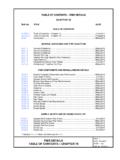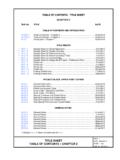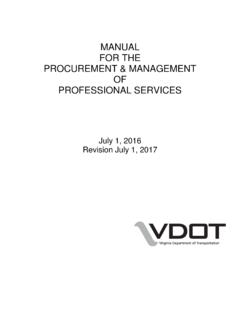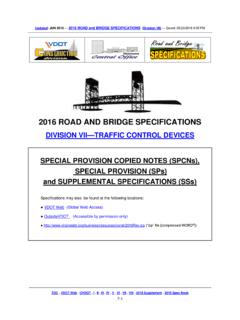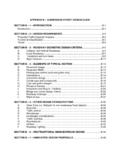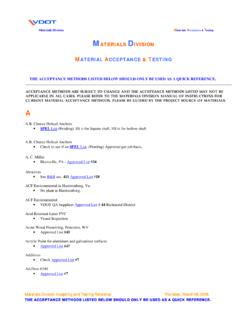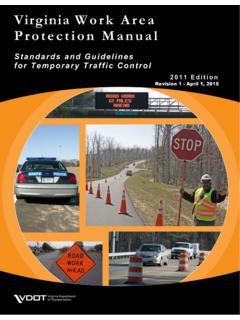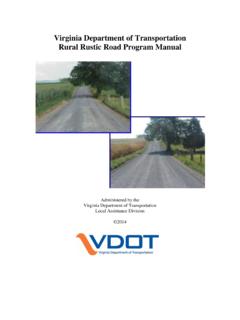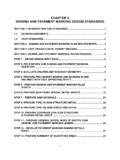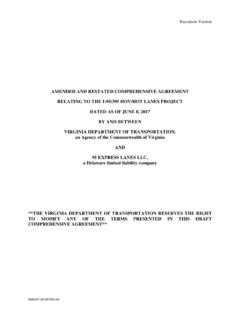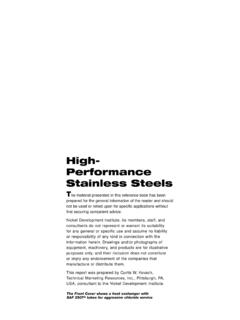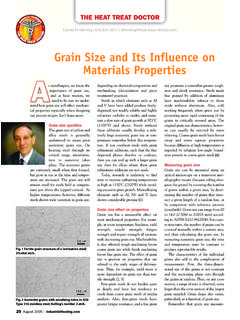Transcription of Introduction to LRFD, Loads and Loads Distribution
1 Introduction to LRFD1-1 Introduction to LRFD, Loads and Loads DistributionThomas K. Saad, Highway AdministrationChicago, ILEvolution of Design MethodologiesSLD Methodology:(ft)D+ (ft)L , (ft)D+ (ft)L FyLFD [ (ft)D+ 5/3(ft)L] Fy, (ft)D+ (ft)L Fy( by judgment) lrfd (ft)D+ (ft)L Fy( by calibration)(new live- load model) Introduction to LRFD1-2 Evolution of Design Methodologies (cont d)SLD does not recognize that some types of Loads are more variable than provides recognition that types of Loads are provides a probability-based mechanism to select load & resistance of Design Methodologies (cont d)As a result, lrfd achieves considerable improvement in the clustering of reliability indices versus the AASHTO Standard Specifications.
2 LFDLRFDRELIABILITY INDEX0123450306090120200 SPAN LENGTH (Feet)RELIABILITY INDEX0123450306090120200 SPAN LENGTH (Feet)RELIABILITY to LRFD1-3 Basic lrfd Design Equation i iQi Rn= RrEq. ( )where: i= D R I i for maximum s i= < for minimum s i= load factor = Resistance factorQi= Nominal force effect Rn= Nominal resistanceRr= Factored resistance = RnIRD1 lrfd Limit StatesThe lrfd Specifications require examination of several load combinations corresponding to the following limit states: SERVICE LIMIT STATE relating to stress, deformation, and cracking FATIGUE & FRACTURE LIMIT STATE relating to stress range and crack growth under repetitive Loads , and material toughness STRENGTH LIMIT STATE relating to strength and stability - (CONSTRUCTIBILITY) EXTREME EVENT LIMIT STATE relating to events such as earthquakes, ice load , and vehicle and vessel collisionIntroduction to load and load Designation STRENGTH I : without wind.
3 STRENGTH II : owner design / permit vehicles without wind. STRENGTH III : wind exceeding 55 mph. STRENGTH IV : very high dead-to-live load ratios. STRENGTH V : vehicular use with 55 mph wind. SERVICE I : normal operational use of the bridge with a 55 mph wind and nominal control cracking of reinforced concrete II : control yielding of steel structures and slip of connectionsSERVICE III : control cracking of prestressed concrete IV : control cracking of prestressed concrete substructures. FATIGUE : repetitive vehicular live load and dynamic responses under a single load and load Designation DD=downdragDC=dead load of structural components and nonstructural attachmentsDW =dead load of wearing surfaces and utilitiesEH=horizontal earth pressureEL=accumulated locked-in force effects resulting from the construction process.
4 Including the secondary forces from post-tensioningES=earth surcharge loadEV=earth fill vertical pressureBR=braking forceCE=centrifugal forceCR=creepCT=vehicular collision forceCV=vessel collision forceEQ=earthquakeFR=frictionIC=ice loadIM=dynamic load allowanceLL=live loadLS=live load surchargePL=pedestrian live loadSE=settlementSH=shrinkageTG=temperat ure gradientTU=uniform temperatureWA =water load and stream pressure WL =wind on live loadWS=wind load on structureIntroduction to LRFD1-5 Permanent Loads (Article )Dead load (Article ):DC -Dead load , except wearing surfaces & utilitiesDC1-placed prior to deck hardening and acting on the noncomposite sectionDC2-placed after deck hardening and acting on the long-term composite sectionDW -Wearing surfaces & utilities acting on the long-term composite sectionLoad Factors for PermanentLoads, pLoad FactorType of LoadMaximumMinimumDC: Component : : Wearing Surfacesand : Horizontal EarthPressure Active : Vertical EarthPressure Overall Stability RetainingStructure Rigid BuriedStructure Rigid to LRFD1-6 Basic lrfd Design Live LoadHL-93 -- (Article )Design Truck: Design Tandem.
5 Pair of KIP axles spaced FT apartsuperimposed onDesign Lane load KLF uniformly distributed Kip/ft+ KIPLRFD Negative Moment Loading(Article )For negative moment (between points of permanent- load contraflexure) & interior-pier reactions, check an additional load case:>50 -0 xIntroduction to LRFD1-7 lrfd Fatigue load (Article )Design Truck only => w/ fixed 30-ft rear-axle spacing Placed in a single lane1 load Combinations and load Factors Use One of These at a Time load Combination Limit State DC DD DW EH EV ES LL IM CE BR PL LS WA WS WL FR TU CR SH TG SE EQ IC CT CV STRENGTH-I p - - TG SE - - - - STRENGTH-II p - - TG SE - - - - STRENGTH-III p - - TG SE - - - - STRENGTH-IV EH, EV, ES.
6 DW DC ONLY p - - - - - - - - - STRENGTH-V p TG SE - - - - EXTREME-I p EQ - - - - - - - - EXTREME-II p - - - - - - SERVICE-I TG SE - - - - SERVICE-II - - - - - - - - SERVICE-III - - TG SE - - - - FATIGUE-LL, IM & CE ONLY - - - - - - - - - - - - Introduction to LRFD1-8 Resistance Factors(Article )Resistance factors, , for the strength limit state shall be taken as follows: For flexure f = For shear v = For axial compression, steel only c = For axial compression, composite c = For tension, fracture in net section u = For tension, yielding in gross section y = For bolts bearing on material bb = For shear connectors sc = For A 325 and A 490 bolts in shear s = For block shear bs = For web crippling w = For weld metal in fillet welds.
7 Tension or compression parallel to axis of the weld same as base metal shear in throat of weld metal e2 = Resistance Factors(Article )Resistance factor shall be taken as: For flexure and tension of reinforced For flexure and tension of prestressed For shear and torsion: normal weight lightweight For axial compression with spirals or ties, except as specified in Article for Seismic Zones 3 and 4 at the extreme event limit For bearing on For compression in strut-and-tie For compression in anchorage zones.
8 Normal weight lightweight For tension in steel in anchorage For resistance during pile Introduction to LRFD1-9 Static Analysis (Article ) Approximate Methods of Analysis (Article ) Beam-Slab Bridges (Article )Structural Analysis & Evaluation (Article 4)Live- load Lateral Distribution FactorsTABLE COMMON DECK SUPERSTRUCTURES COVERED IN ARTICLES AND SUPPORTING COMPONENTS TYPE OF DECK TYPICAL CROSS-SECTION steel Beam Cast-in-place concrete slab, precast concrete slab, steel grid, glued/spiked panels, stressed wood Closed steel or Precast Concrete Boxes Cast-in-place concrete slab Open steel or Precast Concrete Boxes Cast-in-place concrete slab, precast concrete deck slab Cast-in-Place Concrete Multicell Box Monolithic concrete Cast-in-Place Concrete Tee Beam Monolithic concrete Precast Solid.
9 Voided or Cellular Concrete Boxes with Shear Keys Cast-in-place concrete overlay Precast Solid, Voided, or Cellular Concrete Box with Shear Keys and with or without Transverse Posttensioning Integral concrete Introduction to LRFD1-10 Table Distribution of Live Loads Per Lane for Moment in Interior Beams. Type of Beams Applicable Cross-Section from Table Distribution Factors Range of Applicability One Design Lane Loaded: + Two or More Design Lanes Loaded: Lt + 10,000 Kg 7,000,000 Concrete Deck, Filled Grid, Partially Filled Grid, or Unfilled Grid Deck Composite with Reinforced Concrete Slab on steel or Concrete Beams.
10 Concrete T-Beams, T- and Double T-Sections a, e, k and also i, j if sufficiently connected to act as a unit use lesser of the values obtained from the equation above with Nb = 3 or the lever rule Nb = 3 Live- load Distribution FactorsFor Moments Interior BeamsNotes: 1) Units are in LANESand not WHEELS!2) No multiple presence factorIntroduction to LRFD1-11 Table Distribution of Live load per Lane for Shear in Interior Beams. Type of Superstructure Applicable Cross-Section from Table One Design Lane Loaded Two or More Design Lanes Loaded Range of Applicability + + Concrete Deck, Filled Grid, Partially Filled Grid, or Unfilled Grid Deck Composite with Reinforced Concrete Slab on steel or Concrete Beams; Concrete T-Beams, T-and Double T-Sections a, e, k and also i, j if sufficiently connected to act as a unit Lever Rule Lever Rule Nb = 3 Live- load Distribution FactorsFor Shear Interior BeamsNotes: 1) Units are in LANESand not WHEELS!
